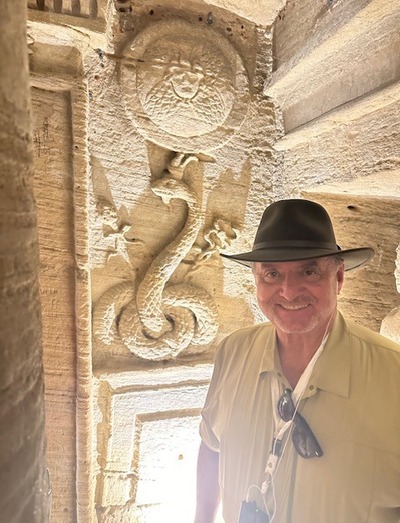-
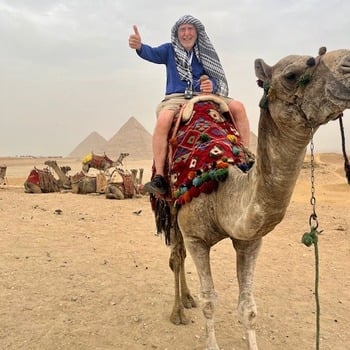 June 4, 2024
June 4, 2024By Deacon Ed Sheffer
Egypt is referred to as The Land of Ra, a reference to their primary ancient sun god. Along with Bishop Gerald Kicanas, I recently led a group of 28 Catholics on a pilgrimage there. Egypt awakened my senses in particular ways. I found the mix of ancient civilization and the exciting modern dynamism quite stimulating. There is a timeless aura to it and, at the same time, there is a war torn feel to it. Our pilgrimage group explored Egypt’s beautiful cities, its natural wonders, and we floated up the longest river in the world. I was intrigued by it all.

First stop: Cairo, located on the Nile River, it
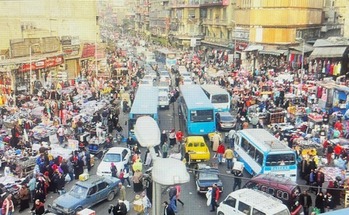 is known by many names, but in Arabic as Al-Qahirah; meaning – The Victorious. As we entered the city, we were introduced to Egypt’s driving code of conduct, or correctly stated, the lack there of. Driving lanes serve no purpose and there are zero rules for pedestrian crossing. A loud horn along with an expressive voice is essential. It seems to me there is a victory in getting to your destination and back each day with your car intact and, in the case of pedestrians, your life intact. Cairo is an extremely busy city, with a population of 6.67 million and an additional 10 million who live just outside the city boundaries.
is known by many names, but in Arabic as Al-Qahirah; meaning – The Victorious. As we entered the city, we were introduced to Egypt’s driving code of conduct, or correctly stated, the lack there of. Driving lanes serve no purpose and there are zero rules for pedestrian crossing. A loud horn along with an expressive voice is essential. It seems to me there is a victory in getting to your destination and back each day with your car intact and, in the case of pedestrians, your life intact. Cairo is an extremely busy city, with a population of 6.67 million and an additional 10 million who live just outside the city boundaries.  After a night’s rest, we travelled a short distance to the Great Pyramids of Giza, a testament to Egypt’s distinguished past and architectural skillfulness. On the one hand, I was struck by a sense of wonderment. The magnitude of creativity in assembling these extraordinary tombstones of the kings is mind-boggling. On the other hand, what rests at the motivation to create them reveals something quite telling. In the end, man makes himself out to be God, so he can try to feel less fearful, justify his choices in life, and buy into the lie that he is in control of his ultimate destiny (I’m sure that would never happen
After a night’s rest, we travelled a short distance to the Great Pyramids of Giza, a testament to Egypt’s distinguished past and architectural skillfulness. On the one hand, I was struck by a sense of wonderment. The magnitude of creativity in assembling these extraordinary tombstones of the kings is mind-boggling. On the other hand, what rests at the motivation to create them reveals something quite telling. In the end, man makes himself out to be God, so he can try to feel less fearful, justify his choices in life, and buy into the lie that he is in control of his ultimate destiny (I’m sure that would never happen today). The Egyptian kings spent the bulk of their life ensuring the erection of their pyramid, more than a grandiose tribute to themselves. These pyramids gave testimony to others of the glorification after death that awaited them. These tombs were filled with all the beautiful things a future god might need to sustain himself in the next world. How paradoxical and yet there is a compatibility with an ultimate truth. One does need to seek in this world what will sustain them in the next.
today). The Egyptian kings spent the bulk of their life ensuring the erection of their pyramid, more than a grandiose tribute to themselves. These pyramids gave testimony to others of the glorification after death that awaited them. These tombs were filled with all the beautiful things a future god might need to sustain himself in the next world. How paradoxical and yet there is a compatibility with an ultimate truth. One does need to seek in this world what will sustain them in the next. One of the great highlights of the pilgrimage was to visit and pray inside the Church of Abu Serga, which houses the location where the Holy Family sought refuge in Egypt. Enclosed in the church is the cavern where Jesus, Mary, and Joseph had shelter. I snuck away for a short time and was given entry into the sleeping quarters of St. Joseph, where I left some petitions with him.
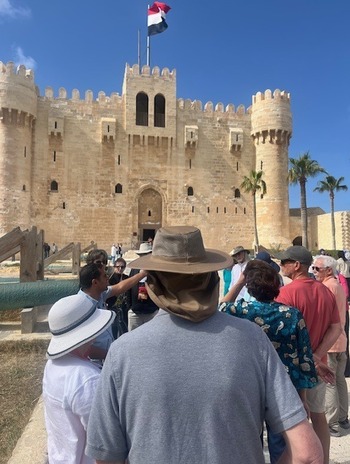 We were off next to Alexandria, known as either The Bride or The Pearl of the Mediterranean; either way it is one of the prettiest places in Egypt. This coastal city has a rich history. It is home to the Citadel of Qaitbay, where the Lighthouse of Alexandria is, one of the Seven Wonders of the World. The construction of the lighthouse there was a marvel. Its purpose though, like all lighthouses is the same, to provide warning and to guide one to safety while on their way. I find it compelling that St. Mark the Evangelist chose this city to introduce Christianity here in 42 AD. He was martyred in this location. It was from here that the faith spread throughout Egypt and into Africa. Origen, one of the most important early Church Fathers, a theologian and scripture scholar came from Alexandria. Clement, another Church Father followed him, and provided warning and guided against the early heresy of Gnosticism (finding one’s way through intellectual enlightenment - becoming your own god). Enjoying coffee in the morning on the Mediterranean was beyond charming.
We were off next to Alexandria, known as either The Bride or The Pearl of the Mediterranean; either way it is one of the prettiest places in Egypt. This coastal city has a rich history. It is home to the Citadel of Qaitbay, where the Lighthouse of Alexandria is, one of the Seven Wonders of the World. The construction of the lighthouse there was a marvel. Its purpose though, like all lighthouses is the same, to provide warning and to guide one to safety while on their way. I find it compelling that St. Mark the Evangelist chose this city to introduce Christianity here in 42 AD. He was martyred in this location. It was from here that the faith spread throughout Egypt and into Africa. Origen, one of the most important early Church Fathers, a theologian and scripture scholar came from Alexandria. Clement, another Church Father followed him, and provided warning and guided against the early heresy of Gnosticism (finding one’s way through intellectual enlightenment - becoming your own god). Enjoying coffee in the morning on the Mediterranean was beyond charming. 
We were blessed to spend a day at Catholic Relief Services (CRS) in Egypt. There is a 110-person team there doing remarkable work. They seek to bring human dignity to people of all backgrounds in Egypt and, in a most needed way, to refugees. Currently, two of the staff are literally putting their lives on the line, actively involved in striving to bring much needed humanitarian help to Gaza.
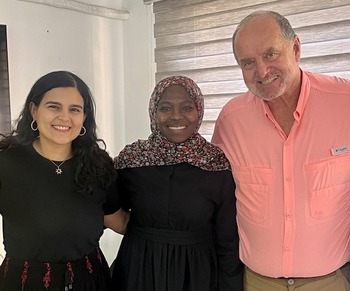 Additionally, I met a young black woman, Katawa, from Sudan. We had a heartfelt conversation about human suffering, loss, hope, and love. She has pretty much lost everything and, in real terms, is a displaced person seeking a future. CRS made it possible for her to complete her high school studies, then go on to graduate with honors from university. CRS is helping her now to get into post graduate work studying bioethics. She longs to go back home and make a difference in the lives of others in her homeland.
Additionally, I met a young black woman, Katawa, from Sudan. We had a heartfelt conversation about human suffering, loss, hope, and love. She has pretty much lost everything and, in real terms, is a displaced person seeking a future. CRS made it possible for her to complete her high school studies, then go on to graduate with honors from university. CRS is helping her now to get into post graduate work studying bioethics. She longs to go back home and make a difference in the lives of others in her homeland. 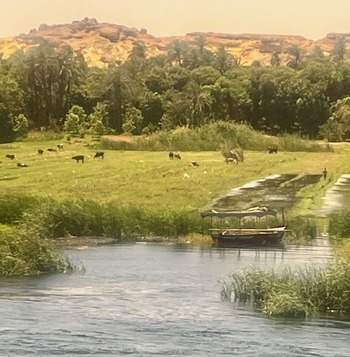
The Nile Cruise we took was a voyage through the heart of Egypt, it allowed us to take in much of its rich history, while enjoying stunning landscapes. As I sat on the upper deck, of the upscale Steigenberger Legacy Cruise Ship, I enjoyed my daily double-expresso (shout out to Kalil & Mohammed for their daily attendance and Bashar for making a fine temporary acolyte). As I enjoyed the scenery, and watched people scurrying around the shore, the image popped in my head of a baby floating in a basket – Moses being rescued and then his setting out on a destiny God had planned for him that he could never have imagined. I thought about one of the encounters he had with Pharaoh, where the king was dismissive of what Moses was offering: “Who is the Lord, that I should obey him… I do not know the Lord…” (Exodus 5:2). Life’s greatest tragedy is not to know God and His love, and to walk away from this ultimate purpose for one’s life. As Mark Twain once said, “Denial just ain’t a river in Egypt.”
he had with Pharaoh, where the king was dismissive of what Moses was offering: “Who is the Lord, that I should obey him… I do not know the Lord…” (Exodus 5:2). Life’s greatest tragedy is not to know God and His love, and to walk away from this ultimate purpose for one’s life. As Mark Twain once said, “Denial just ain’t a river in Egypt.” While in Luxor, we explored a treasure trove of monuments, temples, and tombs. The Karnak Temple was constructed thousands of years ago. Each king added his own touch and style to his final resting place. On the outskirts of the city lies the Valley of the Kings. It is here that the tomb of the famous boy-king, Tutankhamun, was found in 1922. It had been buried and the tomb-raiders didn’t know of its existence. The tomb and items found in them were fully intact and, after seeing them firsthand, I confirm they are magnificent, iconic finds.
There is a serene beauty to Aswan, where it appears there is a slower more relaxed place to live in Egypt. There is some significant ancient and modern historical significance in this mesmerizing destination. The Temple of Philae is here, dedicated to the goddess Isis. The ancient “Holy Trinity,” of Asar, Aset, and Heru, renamed by the Greeks to Osiris, Isis, and Horus, were a father, mother, and son.
The Aswan High Dam is an engineering marvel. Its main purpose for construction was to address the flooding of the Nile. Little was it known the massive impact it would have on their economy, culture, and adding to the beauty of Egypt.

On our final day, we visited Cave Church, located just outside Cairo, in an area known as Zabbaleen City, meaning literally Garbage City. It was a bit of a challenge to get there. We first had to pass through the community that collects and recycles all the garbage for Cairo. But it was absolutely worth the effort. This site is remarkable for several reasons, the least of which is not for its lack of magnificent beauty. The Coptic Christians that live here now are descendants of farmers of Upper Egypt who migrated to Cairo because of the abject poverty they were living in. In the 1960s, the governing power didn’t want them in Cairo anymore, so they were relocated under the cliffs of Mukattam Mountain and these Coptic Christians started establishing Zabbaleen City. We were able to celebrate Mass here and it was very moving for me. Afterwards, I was able to spend a few minutes with one of the sacristans here. Baram acknowledged there are life differences here, but he told me that he lives for God, he trusts in Jesus, and he isn’t afraid of anything or anybody, “Jesus will do best for us in the end no matter how much bad others want to bring us. Jesus will keep us safe.” I placed some Egyptian pounds in his hand and asked if I could bless him. He said, “May God be with you too.” He then asked me to pray for him and all those engaged in trying to share the Gospel in Egypt.
Egypt looks different for Christians from 10 years ago, when the Muslim brotherhood was in power. The Egyptian government today has given Christians more freedom than ever before in modern history. That said, it was quite clear to me, driving through the Christian section of Cairo, that they still struggle mightily. The Muslims and Christians may be brother and sister Egyptians in name, but the bulk of their living conditions reveal that a great distance separates them.
It was quite revealing to learn that the symbol of the cross we Christians use was developed by the early Church in Egypt and adapted from the Egyptian Ankh.
 Not so coincidentally, the ankh meaning symbolizes the many aspects of life; physical, eternal, immortality, death, and after life.
Not so coincidentally, the ankh meaning symbolizes the many aspects of life; physical, eternal, immortality, death, and after life. I was intrigued by the idea of the Egyptian family of gods. Karnak Temple is the most important place of worship in ancient Egypt. In it are the Triad of Thebes: Amun (who would evolve into the sun god Ra), Mut (the divine world mother), and Konsu (the son of Amun and Mut): family; father, mother, and son. Although the idea of triune god is a pagan concept and although the ancient Triad and triune deities may be three separate persons, pagan triads of gods are not anything like the Christian belief in a Triune God. The Trinity is the central doctrine of all of Christianity. The pagan triads were part of a pantheon of many gods. The elevated concept of the one true God, that rests in the Trinity leads to an elevated concept of the dignity of the human person and the glory that awaits that person.
A shout out to Canterbury Pilgrimages and all they did to make this pilgrimage so wonderful. Thank you also to Bishoi, our Egyptian escort, as a tour guide, on a scale of one to 10, you are an 11. As for my fellow wayfarers, you inspired me in many ways, the least of which wasn’t your lack of kindness toward one another. We shared some sacred moments and had some profound encounters. I am grateful for your senses of humor, patience, tenacity, smiles, laughter, curiosity, and desire to grow, especially closer to God.
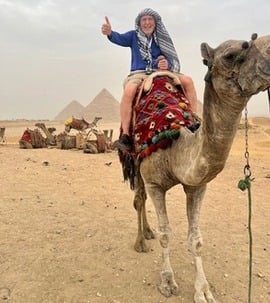 In the nearly 21 years I have been ordained as a Catholic deacon, I have been blessed with more than a handful of positive life-changing experiences shared with a very special instrument of God: Bishop Gerald Kicanas. I have encountered more of life’s deeper meaning than I ever would have, if not for his hand in my life. There are way too many to go into here, but let me say, it gave me great joy and honor to serve at the altar with him in Egypt on the anniversary of his 57 years of being ordained to the priesthood.
In the nearly 21 years I have been ordained as a Catholic deacon, I have been blessed with more than a handful of positive life-changing experiences shared with a very special instrument of God: Bishop Gerald Kicanas. I have encountered more of life’s deeper meaning than I ever would have, if not for his hand in my life. There are way too many to go into here, but let me say, it gave me great joy and honor to serve at the altar with him in Egypt on the anniversary of his 57 years of being ordained to the priesthood. 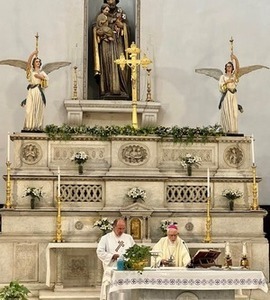
I was called on to preach at four of our Masses. In the gospels those days, each one interestingly touched on Jesus’ being the way, the truth, and the life. We are all called to explore life and to seek truth. Ancient Egyptians believed there were two questions awaiting at the end of life: “Did you bring joy? Did you find joy?” My personal spiritual takeaway from this pilgrimage was: Jesus tells us to follow Him, be grounded in Him. At the heart of a spiritual life rooted in Jesus rests joy. He came to reveal the Father. He came to share the joy that God is. My prayer and my hope is that this divided world might become more united in Him and find the joy we all long for.
